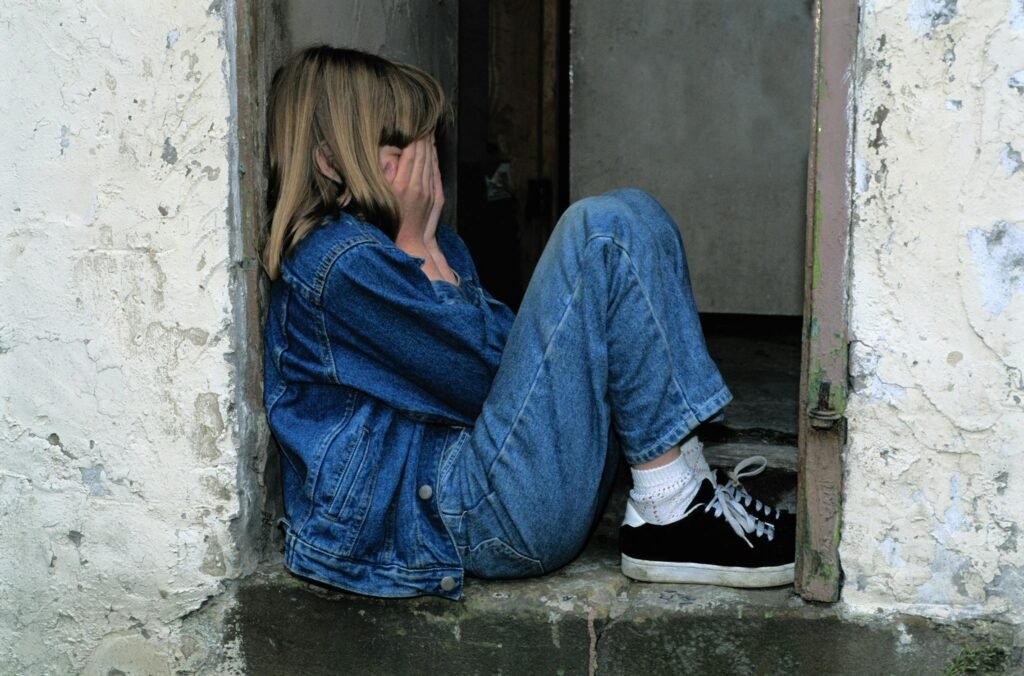Last Updated on February 14, 2025 by Daniele Lima
Risk factors and therapeutic approaches
Childhood depression is an emotional condition that is often underestimated but can have a profound impact on a child’s development as well as their quality of life. Recognizing and appropriately addressing this issue is essential to promoting the well-being of future generations. Unlike adults, children often have difficulty expressing their feelings of sadness or anguish clearly.
This makes recognizing the early signs even more challenging for parents and educators. Being aware of behavioral nuances and associated risk factors is essential to promote early and effective intervention. This surveillance allows for the identification of patterns that may precede the need for assistance, ensuring more appropriate and timely support.
This article investigates the early signs of childhood depression and proposes prevention strategies that range from strengthening family relationships to the implementation of contemporary therapeutic approaches. Acting preventively not only increases the chances of effective treatment, but also helps the child discover healthy ways of dealing with their emotions, promoting a more balanced childhood. This approach is fundamental for emotional and psychological development, providing essential tools for a more harmonious life.
Table of Contents
What is Childhood Depression in Kids: A Complete Guide
Childhood depression transcends the temporary feelings of sadness or irritation that can emerge in moments of frustration. It is an emotional disorder that significantly impacts the way a child feels, thinks, and behaves. This persistent condition can significantly interfere with your daily life and social interactions.
This condition requires special attention to ensure the child’s well-being and healthy development. The signs can be difficult to identify as they often manifest differently compared to adults. It is essential to be aware of these nuances for a better understanding. Furthermore, children do not always have the ability to verbally articulate their emotions, whether deep sadness or helplessness.
Therefore, careful observation by parents, teachers, and caregivers is essential. Next, we will examine the first signs that deserve our attention.
Early Warning Signs of Depression in Children
Identifying the first signs of childhood depression can be challenging, as children often express their emotions differently than adults. Here are some significant signs that may indicate that your child is experiencing a period of depression:
Childhood Depression Symptoms: Changes in Mood and Behavior

Changes in Mood
Mood variations may represent the first warning signs. The child may present a continuous state of sadness, discouragement, or irritability. These emotional manifestations may be indicative of something deeper. A frequent change is a decrease in interest in activities that previously provided pleasure, such as playing or socializing with friends.
Changes in Appetite and Sleep
Children facing depression can show considerable variations in their appetite, alternating between a very reduced food intake or, on the other hand, an excessive increase in food consumption. In a similar way, sleep patterns can be influenced: the child may have difficulty falling asleep, experience insomnia or, conversely, sleep more than usual.
Drop in School Performance
Childhood depression can have a significant impact on academic performance. The child may face challenges with concentration, show unsatisfactory academic performance or show a lack of interest in school activities. These difficulties may be indicative of issues that deserve attention.
Another indicator of childhood depression is social isolation. Children who were previously sociable may gradually withdraw from friends and family, opting for moments of solitude. This behavior could be a sign of emotional changes or internal challenges they are facing.
Physical Complaints
It is common for many children to demonstrate their emotional distress through physical symptoms, such as headaches, stomach discomfort, or excessive fatigue, often without an identifiable medical cause.
Aggressive Behavior or Irritability
It is important to note that some children may not express sadness directly, but rather through irritability or aggressive behavior. They may become more impatient and frustrated, displaying outbursts of anger for no apparent reason. These unexpected reactions can be challenging to deal with.
Risk Factors for Depression in Children
Why Understanding These Risks Matters
Depression in children is often misunderstood or overlooked. Identifying risk factors early can help in taking proactive steps to support a child’s mental health.
Key Risk Factors for Childhood Depression
- Family History of Depression: Children with parents or close relatives suffering from depression have a higher genetic and environmental risk.
- Stressful Life Events: Events such as parental divorce, loss of a loved one, or sudden changes in environment can trigger depressive symptoms.
- Dysfunctional Family Environment: Exposure to conflict, domestic violence, or emotional neglect significantly increases a child’s vulnerability.
- Health Problems: Chronic illnesses like asthma and diabetes can contribute to depression due to their impact on daily life.
- Low Self-Esteem & Bullying: Children struggling with self-image or being bullied often experience feelings of inadequacy and rejection.
What Parents Can Do
Providing emotional support, open communication, and seeking professional guidance when needed can help mitigate these risks and improve a child’s well-being.
Preventing Childhood Depression: Effective Strategies for Parents
Prevention stands out as one of the most effective approaches to tackling childhood depression. By taking a preventative approach, parents and educators have the opportunity to cultivate robust emotional resilience in children. This practice not only strengthens character but also prepares children to face life’s challenges in a more balanced way. Certain prevention strategies include:
Promote a Safe and Welcoming Family Environment
Emotional support at home is essential. Ensuring that children feel loved, valued, and in a safe environment contributes to the development of healthy self-esteem, which, in turn, can act as a preventative factor against depression. This solid emotional foundation is fundamental to well-being and emotional resilience in the future.
Encourage Emotional Expression
It is essential to teach children to recognize and express their feelings from the first years of life. This can be achieved through transparent dialogues and encouraging the use of emotional language. It is essential to monitor the child’s social environment, especially in the school context, as an essential preventive strategy. Encouraging healthy interactions and being aware of bullying can prevent social isolation.
Encouraging the Practice of Physical Activities
Practicing physical activities has a significant impact on mental health. Practicing sports and outdoor activities is an excellent way to stimulate the release of endorphins, thus promoting emotional well-being. Furthermore, this activity can act as a preventive factor against symptoms of depression. By engaging in games and physical exercises, they strengthen not only the body but also the mind.
Treatment Options for Childhood Depression: A Parent’s Guide
Seek Professional Help When Needed
In certain situations, early intervention by a child psychologist or psychiatrist may become essential. Not hesitating to seek specialized help is a crucial measure to ensure the child’s well-being. This attitude reflects a commitment to childhood health and development.
Cognitive-Behavioral Therapy (CBT)
CBT stands out as one of the main therapeutic approaches for treating childhood depression. It helps the child identify negative thoughts, promoting their replacement with healthier patterns of thinking and behavior. This approach favors emotional and cognitive development, allowing for more balanced growth.
Family Therapy
In several cases, the inclusion of the family in the treatment process proves to be fundamental, especially when the family context influences the child’s condition. Family therapy has the potential to resolve conflicts and improve communication in the home environment. This therapeutic process promotes mutual understanding and strengthens emotional bonds between family members.
In more severe situations, the administration of medication may be recommended, always under the supervision of a healthcare professional. Antidepressants have the ability to balance chemical levels in the brain; however, their use in children is closely supervised. This rigorous monitoring is essential to ensure the safety and effectiveness of the treatment.
🧠 Childhood Depression Monitoring
Use this interactive toolkit to track symptoms, monitor sleep and mood patterns, and improve parent-child communication.
📌 1. Symptom Checker Tool
Identify early warning signs of depression:
Persistent sadness or irritabilityLoss of interest in activities
Changes in eating or sleeping habits
Difficulty concentrating in school
Frequent mood swings
Talks about feeling hopeless or worthless
📅 2. Mood Tracker Calendar
Track emotional fluctuations over the month:
🌙 3. Sleep Pattern Calculator
Monitor sleep disturbances:
🎯 4. Activity Engagement Meter
Assess daily activity levels:
Plays with friends regularlyEnjoys hobbies or sports
Participates in family activities
Shows interest in learning
🗣️ 5. Parent-Child Communication Planner
Improve conversations about mental health:
I check in with my child dailyI encourage open discussions about feelings
We spend dedicated one-on-one time together
I create a safe, judgment-free space for my child
Read more on childhood mental health.
Explore depression warning signs.
Conclusion: The Importance of Early Recognition and Support
Childhood depression is a condition that demands attention, empathy, and, above all, immediate intervention. Recognizing the initial signs and understanding the risk factors, as well as adopting preventive and therapeutic strategies, can be fundamental to the child’s development. These actions have the potential to transform lives and provide a healthier and more promising future.
Ensuring an emotionally healthy environment and seeking professional support when necessary are essential actions for long-term child well-being. This commitment is crucial for the healthy development of children. In this way, it is possible to offer children a happier and more harmonious future, facilitating their development with emotional and mental health.
Frequently Asked Questions About Childhood Depression
At what age can childhood depression start?
Childhood depression can begin as early as age 3, though it’s more commonly diagnosed in school-age children. Each child may show different symptoms at different ages.
How can I tell if my child is depressed or just sad?
Depression differs from normal sadness by its duration (lasting more than two weeks), intensity, and impact on daily activities. Look for persistent changes in sleep, appetite, social interaction, and school performance.
Can childhood depression go away on its own?
While temporary sad feelings may resolve naturally, clinical depression typically requires professional intervention. Early treatment leads to better outcomes.
Is medication necessary for treating childhood depression?
Not always. Treatment plans are individualized and may include therapy alone or a combination of therapy and medication, depending on severity and age.
How can parents prevent childhood depression?
Prevention strategies include creating a supportive home environment, encouraging open communication, promoting physical activity, and maintaining consistent routines.









Leave a Reply